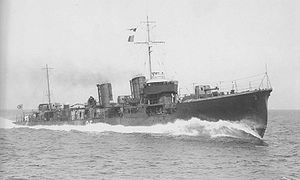Japanese destroyer Uzuki (1925)
 Uzuki in August 1926
| |
| History | |
|---|---|
| Name | Uzuki |
| Namesake | April |
| Builder | Ishikawajima Shipyards |
| Laid down | 11 January 1924 as Destroyer No. 25 |
| Launched | 15 October 1925 |
| Completed | 14 September 1926 |
| Renamed | As Uzuki, 1 August 1928 |
| Stricken | 10 January 1945 |
| Fate | Sunk by PT boats on 12 December 1944 |
| General characteristics | |
| Class and type | Mutsuki-class destroyer |
| Displacement |
|
| Length |
|
| Beam | 9.16 m (30 ft 1 in) |
| Draft | 2.96 m (9 ft 9 in) |
| Installed power |
|
| Propulsion | 2 shafts; 2 × Kampon geared steam turbines |
| Speed | 37.25 knots (68.99 km/h; 42.87 mph) |
| Range | 4,000 nmi (7,400 km; 4,600 mi) at 15 knots (28 km/h; 17 mph) |
| Complement | 150 |
| Armament |
|
| Service record | |
| Part of: | Destroyer Division 23 |
| Operations: | |
Uzuki (卯月, "April") was one of twelve Mutsuki-class destroyers built for the Imperial Japanese Navy (IJN) during the 1920s. During the Pacific War, she participated in the Battle of Wake Island in December 1941 and the occupations of New Guinea and the Solomon Islands in early 1942.
History

Construction of the Mutsuki-class destroyers was authorized as part of the Imperial Japanese Navy's build up from fiscal 1923 of ships not covered by the
In the late 1930s, Uzuki participated in combat actions in the
World War II history
At the time of the
Uzuki was assigned to the
In January 1944, Uzuki escorted the cruiser
On 12 December, while escorting a troop convoy from Manila to Ormoc, Uzuki was torpedoed by the PT boats PT-490 and PT-492, 50 miles (80 km) northeast of Cebu at 11°03′N 124°23′E / 11.050°N 124.383°E,[5] exploding and sinking with the loss of 170 crew including Lieutenant Commander Watanabe, 59 survivors.
Uzuki was struck from the
Notes
- ^ Howarth, The Fighting Ships of the Rising Sun.
- ^ Nishidah, Hiroshi (2002). "Mutsuki class 1st class destroyers". Materials of the Imperial Japanese Navy. Archived from the original on 21 July 2012. Retrieved 1 February 2009.
- ^ Morison. The Rising Sun in the Pacific 1931 – April 1942.
- ^ Dull. A Battle History of the Imperial Japanese Navy
- ^ Nishidah, Hiroshi (2002). "Mutsuki class 1st class destroyers". Materials of the Imperial Japanese Navy. Archived from the original on 21 July 2012. Retrieved 1 February 2009.
- ^ *Nevitt, Allyn D. (1997). "IJN Uzuki: Tabular Record of Movement". Long Lancers. combinedfleet.com.
References
- Chesneau, Roger, ed. (1980). Conway's All the World's Fighting Ships 1922–1946. Greenwich: Conway Maritime Press. ISBN 0-85177-146-7.
- Howarth, Stephen (1983). The Fighting Ships of the Rising Sun: The Drama of the Imperial Japanese Navy, 1895–1945. Atheneum. ISBN 0-689-11402-8.
- Jentschura, Hansgeorg; Jung, Dieter & Mickel, Peter (1977). Warships of the Imperial Japanese Navy, 1869–1945. Annapolis, Maryland: United States Naval Institute. ISBN 0-87021-893-X.
- ISBN 0-316-58305-7.
- Nevitt, Allyn D. (2009). "IJN Uzuki: Tabular Record of Movement". Long Lancers. Combinedfleet.com. Retrieved 10 November 2015.
- Watts, Anthony J. & Gordon, Brian G. (1971). The Imperial Japanese Navy. Garden City, New York: Doubleday. ISBN 0385012683.
- Whitley, M. J. (1988). Destroyers of World War Two. Annapolis, Maryland: Naval Institute Press. ISBN 0-87021-326-1.
